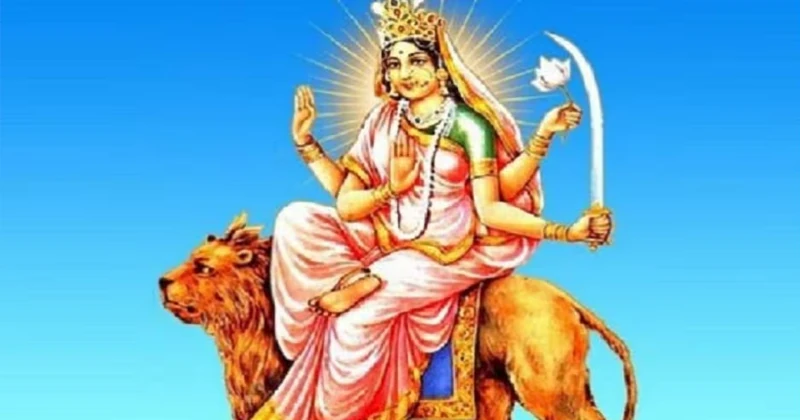In the rich tapestry of Hindu mythology, the Navadurga—nine forms of the goddess Durga—hold a special place. Each form represents a unique aspect of the divine feminine, embodying different virtues and powers. Among these, Chandraghanta Devi, the third manifestation of Durga, stands out for her blend of serenity and ferocity. Worshipped on the third day of Navratri, Chandraghanta Devi symbolizes courage, grace, and the power to vanquish evil.
The Iconography of Chandraghanta Devi
Chandraghanta Devi is depicted as a ten-armed goddess riding a tiger or lion, signifying bravery and strength. Her name, “Chandraghanta,” is derived from the crescent moon (Chandra) shaped like a bell (Ghanta) adorning her forehead. This crescent moon is a symbol of eternal peace and tranquility, while the bell represents the sound that dispels negative energies and evil spirits. Her ten hands carry various weapons, including a trident, mace, sword, and bow, along with a lotus and a rosary, illustrating her readiness to battle malevolence while also bestowing blessings upon her devotees.
The Legend of Chandraghanta Devi
The story of Chandraghanta Devi is both inspiring and enlightening. According to Hindu scriptures, after marrying Lord Shiva, Parvati adorned her forehead with a half-moon shaped like a bell, thus earning the name Chandraghanta. When the gods and sages were tormented by the demon Mahishasura, it was Chandraghanta who emerged to protect them. Her fierce form struck terror in the hearts of demons, while her serene demeanor provided solace to the gods. This duality of her nature—fierce warrior and compassionate mother—makes Chandraghanta a powerful symbol of divine femininity.
Significance in Navratri
During the nine-day festival of Navratri, each day is dedicated to one of the nine forms of Durga. The third day, known as Tritiya, is dedicated to Chandraghanta Devi. Devotees pray to her for courage, strength, and protection against evil. Worshipping Chandraghanta Devi is believed to bring peace and prosperity, dispels fears, and grants the strength to overcome challenges. Her blessings are sought for achieving balance in life, combining the fierceness required to tackle adversities with the calm needed for inner peace.
Symbolism and Teachings
Chandraghanta Devi’s form is rich with symbolism. The crescent moon on her forehead signifies mental clarity and the dispelling of darkness. Her ten arms, each holding a different weapon, represent the multifaceted nature of divine power and the ability to combat various forms of evil. The lion or tiger she rides symbolizes courage and the willingness to face fears head-on.
Her teachings emphasize the importance of balance in life. Just as she embodies both fierceness and serenity, devotees are encouraged to cultivate strength and resilience while maintaining inner peace and compassion. This balance is essential for personal growth and spiritual development.
Rituals and Offerings
Worshipping Chandraghanta Devi involves various rituals and offerings. Devotees often adorn her idol with yellow flowers, which are considered auspicious. They chant specific mantras and perform aarti (a ritual of worship with light) to seek her blessings. Offerings of milk, sweets, and fruits are made to please the goddess. Fasting and meditation are also common practices, aimed at purifying the mind and body.
Conclusion
Chandraghanta Devi, the third form of Goddess Durga, is a powerful symbol of courage, balance, and divine grace. Her worship during Navratri is a reminder of the strength and serenity that reside within each of us. By invoking her blessings, devotees seek to overcome life’s challenges with resilience and maintain inner peace amidst turmoil. Chandraghanta Devi’s dual nature serves as an enduring inspiration, teaching us that true strength lies in the harmonious blend of fierceness and tranquility.


